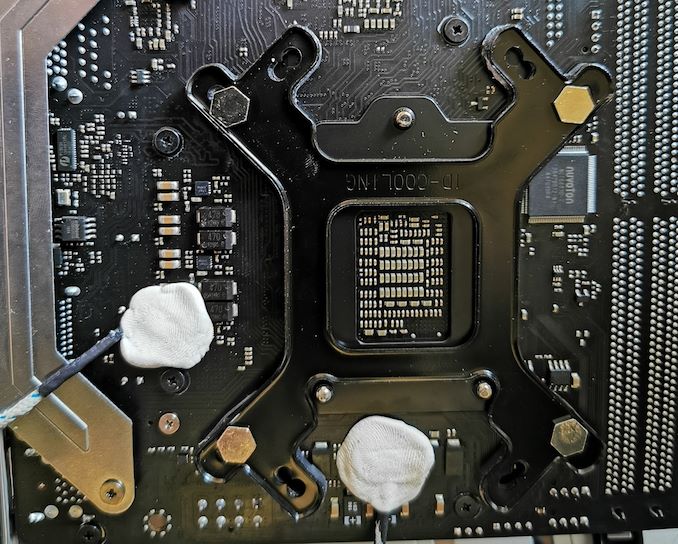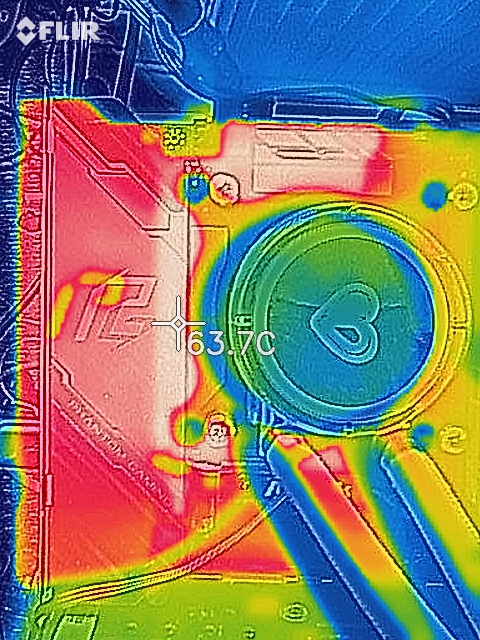AMD + ITX + TB3? It's the ASRock X570 Phantom Gaming-ITX/TB3 Motherboard Review
by Gavin Bonshor on October 9, 2019 12:00 PM ESTPower Delivery Thermal Analysis
One of the most requested elements of our motherboard reviews revolves around the power delivery and its componentry. Aside from the quality of the components and its capability for overclocking to push out higher clock speeds, which in turn improves performance, it is the thermal capability of the cooling solutions implemented by manufacturers that can have the biggest effect. While most solutions are almost always fine for users running processors at default settings, those looking to squeeze out extra performance from the CPU via overclocking put extra pressure on the power delivery. This is why more premium models often include heatsinks on its models with better cooling designs, heftier chunks of metal, and in some cases, even with water blocks such as the ASUS ROG Crosshair VIII Formula.

Two K-Type Thermal Probes attached to the rear of the power delivery on the ASRock X570 Phantom Gaming-ITX/TB3
Testing Methodology
Out method of testing out if the power delivery and its heatsink are effective at dissipating heat, is by running an intensely heavy CPU workload for a prolonged method of time. We apply an overclock which is deemed safe and at the maximum that the silicon on our AMD Ryzen 7 3700X processor allows. We then run the Prime95 with AVX2 enabled under a torture test for an hour at the maximum stable overclock we can which puts insane pressure on the processor. We collect our data via three different methods which include the following:
- Taking a thermal image from a birds-eye view after an hour with a Flir Pro thermal imaging camera
- Securing two probes on to the rear of the PCB, right underneath CPU VCore section of the power delivery for better parity in case a probe reports a faulty reading
- Taking a reading of the VRM temperature from the sensor reading within the HWInfo monitoring application
The reason for using three different methods is that some sensors can read inaccurate temperatures, which can give very erratic results for users looking to gauge whether an overclock is too much pressure for the power delivery handle. With using a probe on the rear, it can also show the efficiency of the power stages and heatsinks as a wide margin between the probe and sensor temperature can show that the heatsink is dissipating heat and that the design is working, or that the internal sensor is massively wrong. To ensure our probe was accurate before testing, I binned 10 and selected the most accurate (within 1c of the actual temperature) for better parity in our testing.
For thermal image, we use a Flir One camera as it gives a good indication of where the heat is generated around the socket area, as some designs use different configurations and an evenly spread power delivery with good components will usually generate less heat. Manufacturers who use inefficient heatsinks and cheap out on power delivery components should run hotter than those who have invested. Of course, a $700 flagship motherboard is likely to outperform a cheaper $100 model under the same testing conditions, but it is still worth testing to see which vendors are doing things correctly.
Thermal Analysis Results

We measured 63.7°C on the hottest part of the board during our testing
The ASRock X570 Phantom Gaming-ITX/TB3 uses a 10-phase power delivery which is running in a 4+2 configuration. The CPU section consists of eight ISL99227 60 A power stages which are paired up with four ISL6617A doublers, while the SoC section consists of two ISL99227 60 A power stages. Controlling the power delivery is a Renesas ISL69147 PWM controller. The cooling solution on the ASRock X570 Phantom Gaming-ITX/TB3 consists of two individual heatsinks; one aluminium heatsink which is a combined piece with the rear panel cover, and a separate SoC section which also cools two of the power stages of the CPU section. It's actually a really nice design as the aluminium rear panel cover is quite beefy and will benefit from cases with good passive airflow. -
Looking at our power delivery thermal testing results, the ASRock X570 Phantom Gaming-ITX/TB3 performs pretty well considering it's using a 10-phase design on such a small mini-ITX sized PCB. There are increased thermal properties to consider when running a high-powered mini-ITX system as condensed componentry tends to generate a little bit more heat than a sparser ATX PCB would. With 1.475 V set on the CPU VCore and the CPU Core Frequency set to 4.1 GHz, our temperatures maxed out at 64°C on ASRock's integrated VRM temperature sensor. Our probe on the rear measured 61°C, with our thermal imaging shot measuring 63.7°C on the hottest part of the power delivery. This is a good result for ASRock and although it doesn't quite have the cooling capabilities as some of the flagship models we have tested so far, for a $240 model with so much power and features on a mini-ITX sized model, temperatures in our testing we're absolutely fine. A processor such as the Ryzen 9 3950X with 16-cores is likely to stress the power delivery more than our Ryzen 7 3700X, but it's not likely to push the VRM temperatures into dangerous waters.











64 Comments
View All Comments
GreenReaper - Wednesday, October 9, 2019 - link
I think that's because Thunderbolt at a lower level works over individual 10Gbps lanes. You can have multiple "ports" but then you'll have multiple interfaces - perhaps you can team them at a higher level? But if it's Alpine Ridge you'll almost certainly be limited to low-power 10Gbps.firewrath9 - Wednesday, October 9, 2019 - link
huh? 18TB of SSD storage?My asrock Z87 Extreme11, with its 22 sata ports can do EIGHTY-EIGHT TB OF SSD
WOAH
also if 10gbe costs 100$, why is the X470 Taichi Ultimate only 50$ more than the non-ultimate? (it also has other additonal features)
lmille16 - Thursday, October 10, 2019 - link
Your board is an EATX board. DCide is talking about mITX boards....siuol11 - Friday, October 11, 2019 - link
I'd settle for 2.5 or 5G ethernet, both have readily available chips that cost under $10, and Intel is about to release one (the 225V) that costs less than $2.50.masteraleph - Thursday, October 10, 2019 - link
No, the M.2 is a big deal. If you're stuffing this into a small case- and plenty of people buying X570 ITX boards will- there's a big advantage to not having any 2.5" drives in the case, whether for airflow, cables, what have you.Calamarian - Thursday, April 16, 2020 - link
Shabby:You could always bifurcate the slot and add a 10GB NIC!
Some cases come with!
https://www.sliger.com/products/cases/sm580/
umano - Thursday, October 10, 2019 - link
I am so happy I am not alone with this, 16 cores and thunderbolt means one thing, content creator, not a gamer. I mean the cheapest thing you can attach to TB3 is a 10gbe (200$).There are a lot of video makers and some colourists (who do not need to work with 6-8k raw) that own the x299 itx because it can be portable even in a backpack.
Unless they have the crazy idea of putting a threadripper on a DTX board they lost a great opportunity. This board is a compromise for everyone, too expensive due to tb3 to who is budget-wise, as a gamer I would go with gigabyte for the 2 m2 and the backplate armour (and a very respectable 8 phase vrm) or better the dtx Asus board.
This board can be good only if someone wants a very portable setup with no GPU and they need a faster (x4 PCI 3) GPU. So almost none
I think except Asus maybe, but they were not that good either, manufacturers went very wrong with PCIe 4.0 and the x570.
Asrock could have used the 4x link from the chipset (like only Asus did on their pro board reviewed here) for the second m2, they could have swapped 2xUsb3 5gbs with 2 basic usb3 port for mouse and keyboard with the lanes shared with the wifi module (it will never need full bandwidth and how much data transfer is there for mouse and keyboard) so here you are the 10gbe.
I cannot think the number of devices that can saturate a TB3, 2 x 10gbps usb3 and 2x5gbps.
I have a Wacom tablet, 2 Eizo with 5gbps USB 3 hubs, a das, several and different external drives, HDD, SSD, and a printer. Even with one 10gbps USB, it would have been fine, we can have tb3, who needs to connect 2 nvme external drive? By the way 4 SATA ports without raid 5?
The 2080ti barely (2-3%) saturates a PCI 3 8x link, sharing the lanes between the GPU and the third m2 is not blasphemy at all, so there will be bandwidth, 12x PCIe 4, for a dual GPU card more powerful than a dual 2080ti.
So now I need to change pc and I will buy this board because of the TB3 but I hope they will understand their mistake and someone will release something better, way better
Now I have to spend 250 for the board, 300 for a thunderbolt dock with 10gbe (connected to the NAS) that I cannot use while I am using my raid das, 300+ for 64gb instead of 32gb because I cannot have a fast nvme drive for photoshop/DaVinci cache, and I still don't know how much for 2 custom water block for VRM, and other 40 for the chipset block and probably I will buy a USB DAC for headphones
So I know it is almost impossible to have a sabre and 3 m2 on an itx board but at least for me a board with that stuff and a big block for vrm and chipset, that could have saved some space for extra daughter boards, it is worth more than 900+ and still I would have saved money
I know it is insane and liquid cooling is not for everyone, but an ITX motherboard with 2 m2, tb3, 10gbe and some USB ports (maybe a second tb3) sharing the GPU link it is not unreasonable.
They probably did not do it because they want content creators going with threadripper, but 3d is not the only thing that matter, video has the largest market, and we cannot bring matx cases onset easily, especially because they are ugly and the market is accustomed to see apple products, so we get no money from it, so I will not buy threadripper even I know it is amazing
FiveOhFour - Saturday, January 11, 2020 - link
you have other options come onCheapSushi - Saturday, October 12, 2019 - link
Reaallly wish ASRock and others would push for Mini-DTX! With a second PCIe slot. Put the M.2 somewhere else. :OCalamarian - Thursday, April 16, 2020 - link
With both 10GB USB 3.2 and Thunderbolt I'd bet it's more an issue of available PCIe lanes than MB space...